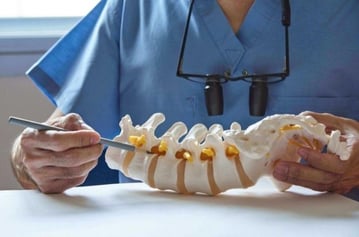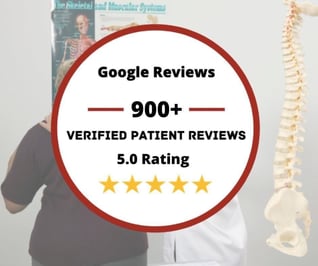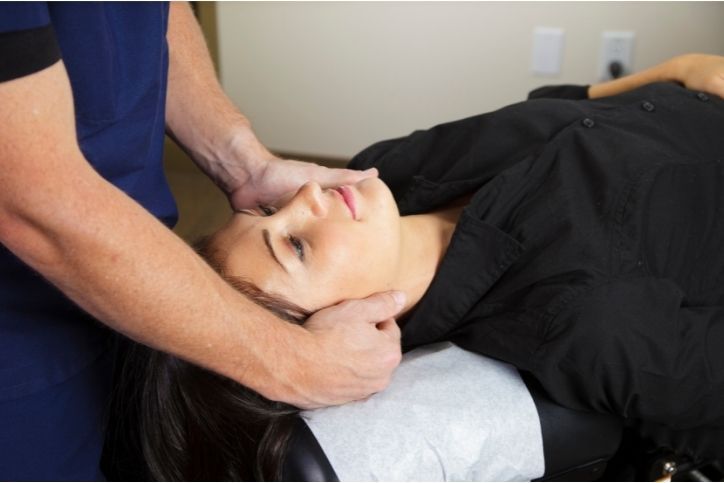Chiropractor in Midtown Atlanta, GA
Our dedicated Midtown Atlanta, Georgia chiropractors and health care professionals have over 40 years of experience treating musculoskeletal injuries and pain symptoms.
Quality Chiropractic Care and Auto Accident Injury Treatment in Midtown Atlanta
Welcome to Arrowhead Clinic! As your Midtown Atlanta chiropractor dedicated to family chiropractic care and spinal health, we invite you to join the thousands of our patients who have found relief from lower back pain, neck pain, sciatica pain, whiplash injuries, migraines, and more.

Dealing with pain and need a same-day appointment?
Our office offers same-day chiropractic treatment appointments and walk-ins, and we are open late and on weekends to make sure you are able to get the care you deserve.

Arrowhead Clinic, as a whole, has 900+ verified Google Reviews.
Our chiropractors are the highest-rated doctors serving the Midtown Atlanta community.

If you were the victim of an accident, we can refer a top personal injury lawyer in Midtown Atlanta. These trusted attorneys help victims of car accidents, truck accidents, motorcycle accidents, and rideshare accidents.
With a personal injury lawyer on your case, you pay no out-of-pocket expenses for your medical treatment after an accident. If you want maximum compensation for your injuries, call us to get connected with an attorney.
MEET DR. JAMES E. TONEY JR.
Dr. Toney didn't grow up wanting to become a chiropractor. After a financial hardship hit his family before starting his freshman year of college, Dr. Toney turned to exercise as an outlet. He would run three to five miles three to four times a week to cleanse his mind and body of all the afflictions he was experiencing.
Dr. Toney soon discovered his love for weight lifting and started to see results immediately. Gaining 20 lbs of muscle the first three months of lifting fueled his development into becoming a bodybuilder. Through bodybuilding, Dr. Toney was able to improve his appearance while maintaining a healthy lifestyle.
After 18 months of bodybuilding, Dr. Toney suffered every athlete's worst nightmare, an injury. This wasn't just any injury, but a back injury caused by improper form on a cable machine workout. At the time, Dr. Toney had no health insurance and couldn't afford to see a medical doctor. He did some research and stumbled upon chiropractic treatment. During his first exam, Dr. Toney was given an X-ray and an adjustment. He was back in the gym in less than a week. That's when he discovered his newly found love for Chiropractic.
Dr. Toney graduated from Georgia Southern University with a BA in Biology and minors in Chemistry and Business Management. He then finished up his education at Life University, where he received a Masters in Exercise Science/Sports Chiropractic with an emphasis in Sports Injury, and a Doctorate in Chiropractic Medicine.
"You never know where life is going to take you, so enjoy the journey." -Dr. James E. Toney Jr., DC

Schedule an Appointment With a Chiropractor Near Me
Arrowhead Clinic is the recognized leader for diagnosing and treating auto accident injuries.
For over 40 years, our team of medical providers and chiropractors have collaborated to stabilize and treat trauma caused by motor vehicle crashes.
We use scientifically-based equipment and the most up-to-date treatment methods such as:
Computer-Guided Spinal Decompression, Active Release Therapy, Electro Muscle Stimulation, Functional Movement Screening, and Fascial Distortion Model.
While our chiropractors pride themselves on detecting injuries and subluxations through manual palpation and muscle testing, our 3D X-ray technology allows our doctors to uncover hidden issues that are ambushing your performance and keeping you from achieving optimal health.
We provide our patients with a comprehensive rehabilitation program that addresses their complete musculoskeletal system and nervous system. Our goal is to help you achieve abundant health. These programs will help get you on the right path.
You are a unique person!
We believe your treatments should be wholly unique to you as well. At our Midtown Atlanta clinic, we offer customized care solutions for your specific needs.
We want you to take a long-term view of health. Our ultimate goal is for you to live a fulfilling life.
We want you to be able to pick up your grandchildren, play sports, and garden for years to come! That is what this is all about, and we want you to be a part of it!
Schedule a free consultation at Arrowhead Clinic in Midtown for an evaluation of your injuries.
During your initial consultation, you will need to provide your medical history, what you did to become injured, a detailed list of your symptoms while indicating what movements cause pain. These details will help pinpoint the exact location causing you pain and allow your chiropractor to make a treatment plan that works.
Other questions you can expect from your chiropractor:
- When and how did the pain start?
- Is the pain sharp, throbbing, dull, or burning?
- Is your pain constant, or does it come and go?
- Where is your pain located?
- What started the pain?
- Do you notice the pain worsening or improving with specific movements?
The Exam With Our Local Midtown Chiropractor
Dr. Toney will conduct a chiropractic exam that includes comprehensive tests. These tests will consist of blood pressure, pulse, respiration, and reflexes, as well as specific orthopedic and neurological tests to assess:
- Range of motion of the affected body part
- Muscle strength
- Postural stability
- Muscle tone
- Neurological integrity
More advanced testing is possible depending on your injury. Diagnostic studies often used in your chiropractic exam include:
- X-rays
- Laboratory Tests
- MRI (depending on the condition)
After the exam and a study of your medical history, your chiropractor will be able to identify structural abnormalities to diagnose your condition more accurately.
This diagnosis will provide insurance companies with the evidence they need to cover your auto accident treatment plan.
Your Recovery Goals
Dr. Toney at our Midtown Atlanta office will set goals based on your X-ray and exam findings for your individualized plan of care:
- Short-term goals such as lessening pain, increasing muscle balance, and restoring normal joint function.
- Long-term goals are about returning to normal activities and daily living with the absence of pain.
The number of visits is determined by Dr. Toney and will vary for each patient. Often our patients need to be seen more during the first couple of weeks, but visits will become more spaced out as the patient progresses. Eventually, treatment could be reduced to once a week or even once every other week until full recovery is reached.
Our Midtown Atlanta Chiropractors and Medical Doctors treat the following pain and injury conditions:
- Achilles Tendinitis - An Achilles tendon injury can cause stiff joints in your ankles and feet, which can be helped with chiropractic care. It's a powerful treatment option that will get you out of discomfort and feeling better quickly.
- Ankle Sprains - Your chiropractor can assist you in recovering from an ankle injury by decreasing pain and speeding up the healing process. Chiropractic treatment for ankle sprains has been proven in studies.
- Car Accident Injuries - A variety of injuries caused by car accidents are treated by auto accident injury chiropractors. Chiropractors can treat pain in a variety of ways, from non-surgical neck pain treatment to whiplash treatment and more.
- Carpal Tunnel Syndrome - You may choose to pursue conservative treatments, which can help relieve carpal tunnel syndrome symptoms without the hazards associated with intensive therapy. Carpal tunnel syndrome can be treated safely and effectively with chiropractic care.
- Frozen Shoulder/Adhesive Capsulitis - For patients who suffer from frozen shoulder, chiropractic treatments can be a very effective treatment choice. People can reduce their discomfort, enhance their shoulder's range of motion, and speed up their recovery with chiropractic care.
- Golfer's / Tennis Elbow - Chiropractic is a terrific technique to obtain treatment from golfer’s / tennis elbow pain because of the whole-body changes it brings about. A chiropractic adjustment with Arrowhead Clinic can help you improve brain-body communication and reduce inflammation throughout the body.
- Hamstring Pulls/Strains - Yes, chiropractic treatment should be explored as part of your hamstring strain recovery strategy. Both severe hamstring injuries that leave you unable to walk and small hamstring injuries that cause modest pain and discomfort can benefit from chiropractic care.
- Hip Flexor/Psoas Tendinitis - Chiropractic treatment can help relieve hip flexor pain, psoas tendinitis, and stiffness with the right manipulations and adjustments.
- Hip Pain - Hip discomfort can also be relieved with chiropractic treatment. Your chiropractor will build a tailored treatment plan for you after establishing the source of your hip discomfort, which may involve chiropractic adjustments, massage, exercise therapy, and stretching.
- Iliotibial Band Syndrome - If the pain from iliotibial band syndrome persists after stretching, a regular exercise program, and ice, you should consult a chiropractor. The key to recovery is to address the tightness in the iliotibial band.
- Knee Sprains - Despite the fact that most people connect chiropractors with back and neck issues, they are also capable of treating knee discomfort.
- Low Back Pain - Acute low-back pain, one of the most frequent types of back pain, can benefit from spinal manipulation to relieve pain and improve function.
- Neck Pain - Cervical manipulation, a type of chiropractic neck adjustment, loosens up the joints of the cervical vertebrae in the neck. Pinched nerves, muscle spasms, strains, and other contributing causes can all produce pain.
- Patellar Tendinitis - The first step toward rehabilitation is to alleviate your discomfort. Chiropractic adjustments can help relieve discomfort, allowing you to begin your rehabilitation and healing process.
- Plantar Fasciitis - A chiropractor can assist you in doing particular stretches, exercises, and movements to relieve aches and pains. This can help treat plantar fasciitis by reducing inflammation in the bottom of your feet.
- Rotator Cuff Strains - A chiropractor can assist people in recovering from rotator cuff issues without the need for surgery.
- Sciatica - While sciatica pain can be devastating, chiropractic treatment can help to alleviate it in a natural and gentle way. This type of treatment involves alleviating pain without causing costly and dangerous side effects.
- Shin Splints - Chiropractic care has been shown to treat pain from a variety of injuries and medical disorders, including shin splints. Sometimes just one visit is enough to relieve the pain, and other times it takes a few visits to get the discomfort under control.
- Sports Injuries - Performing these activities can cause painful tears, sprains, and strains in your body. Seeing a chiropractor can help you recover from and prevent sports injuries. Chiropractors treat and help prevent neck, back, shoulder, knee, and ankle injuries.
- TMJ - Not only can chiropractic TMJ adjustments help relieve discomfort, but you can also do some soft tissue work at home to help loosen up your jaw muscles and relieve pain. TMJ adjustments are quick and effective at relieving TMJ pain.
- Tension Headaches/Migraines - Tension headaches and migraines can frequently occur. Tension headaches cause discomfort across the head, scalp, and neck. Chiropractic care has been shown to help relieve tension headaches and migraines.
- Whiplash - Spinal manipulation is the most common whiplash treatment, and it entails the chiropractor gently manipulating the affected joint in the restricted direction. Spinal manipulation, often known as a chiropractic adjustment, may involve a brief thrust in that direction.
Whether you are a new walk-in patient dealing with back pain or someone recently injured in an auto accident, Dr. James Toney can help diagnose your condition and provide the right treatments to get you out of pain.
We achieve these results not with harmful muscle relaxers or potent narcotics but with spinal decompression therapy. This therapy uses intermittent spinal traction to take the stress off injured vertebral joints and concurrently hydrates your discs. Our chiropractors also perform chiropractic adjustments to facilitate proper motion in the joints, and electrical stimulation to reduce muscular and nerve pain in localized areas.
Some of those spinal manipulation techniques might include:
Flexion-Distraction Technique- A gentle, hands-on spinal manipulation that involves a pumping action on the intervertebral disc instead of direct force.
Instrument-Assisted Manipulation- Uses a hand-held instrument to allow your chiropractor to apply force without thrusting into the spine.
Specific Spinal Manipulation- Helps restore joint movement using a gentle thrusting technique.
In addition to easing your pain, chiropractic treatment can also boost your immune system, increase your energy, add years to your life, and promote your health and level of fitness.
Being involved in a vehicle collision can put unwanted pressure on delicate nerves and diminish nerve flow to the limbs and vital organs. Once the nervous system is compromised, human body functions are at risk and can cause further issues such as complications with movement, blinking, heart function, regulation of hormones, breathing, and vision. If left untreated, it could lead to depleted nerve energy, pain, fatigue, organ dysfunction, and eventually disease.
By realigning the spine back to health and taking unnecessary pressure off the nerves, patients experience almost immediate pain relief, vitality, healthiness, and increased energy.
Adjusting a spinal joint may (but not always) result in the release of a gas bubble between the joints called cavitation, which makes a popping sound.
The same thing occurs when you “crack” your knuckles.
This natural noise is caused by a sudden decrease in pressure within the joint, which results in dissolved gasses in the joint fluid releasing. It is completely harmless.
Whether you have seen a chiropractor in the past or are seeking a local chiropractor near you for the first time, expect your visit to Arrowhead Clinic in Midtown Atlanta to be different from any healthcare experience you've had before.
Here are a few reasons why our clinic is your perfect solution for pain relief and wellness care:
- We Are Conveniently Located
- Our Chiropractic Clinic Is Open Late
- Same-Day Appointments and Walk-Ins Welcome
- Quality Chiropractic Care by Licensed Professionals and Medical Doctors
- Affordable Personalized Care Plans
- State of the Art Diagnostics
- Scientifically Backed Treatments
Worried about cost?
You shouldn't be.
At Arrowhead Clinic, we take the time to evaluate all insurance options, including medical and auto insurance, to determine the most economical way to get you healthy.
Even if insurance is not an option for you, we offer highly affordable wellness plans!
If you were recently in an auto accident or are dealing with neck or back pain, CALL (800) 961-7246 for a free consultation with one of our doctors. Google Reviews refer to us as the Best Local Chiropractic Clinic in Atlanta.
Dr. James Toney is your local Midtown Atlanta Chiropractor waiting to help you heal.
Contact us today to get started.
Arrowhead Clinic - Midtown Atlanta
Address: 552 Ponce De Leon Ave. NE, Atlanta, GA 30308
Phone: (800) 961-7246
Treating Chiropractor: Dr. James Toney
CITIES SERVED
Atlanta | Druid Hills | Midtown Atlanta | North Druid Hills
COUNTIES SERVED
ZIP CODES SERVED
30301 | 30305 | 30309 | 30313 | 30317 | 30324 | 30331 | 30342 | 30353 | 30361 | 30370 | 30377 | 30388 | 30398 | 31126 | 31196 | 30302 | 30306 | 30310 | 30314 | 30318 | 30325 | 30332 | 30343 | 30354 | 30363 | 30371 | 30380 | 30392 | 31106 | 31131 | 30303 | 30307 | 30311 | 30315 | 30319 | 30326 | 30334 | 30344 | 30355 | 30368 | 30374 | 30384 | 30394 | 31107 | 31193 | 30304 | 30308 | 30312 | 30316 | 30321 | 30327 | 30336 | 30348 | 30357 | 30369 | 30375 | 30385 | 30396 | 31119 | 31195
"They make you feel like family. Everytime I come here, I leave feeling alot better and look forward to the next session. Thanks for everything. Highly recommended if in need of a chiropractor for whatever reason."
"I adore the staff here!! They are always kind and professional while also making you feel like family! I highly recommend!!😁"
"Wonderful place. The staff is really friendly and helpful. They care about your recovery! Would come again if I had too."
About Midtown Atlanta
Midtown Atlanta, sometimes known as Midtown, is a densely populated commercial and residential region in Atlanta, Georgia. Due to differing classifications used by the city, citizens, and local business groups, the precise geographical size of the area is unknown. The commercial heart of the neighborhood, however, is centered by a series of high-rise office buildings, condominiums, hotels, and high-end shopping along Peachtree Street between North Avenue and 17th Street. Midtown is the second-largest economic district in Metro Atlanta, located between Downtown to the south and Buckhead to the north. Midtown has a resident population of 41,681 people and a business population of 81,418 people in 2011.
The Fox Theatre, Woodruff Arts Center, the High Museum of Art, the Center for Puppetry Arts, the Atlanta Symphony Orchestra, and the Museum of Design Atlanta are among the Southeast's most densely packed art and cultural institutions. Midtown receives about 6 million people every year, largely as a result of major yearly events such as the Atlanta Dogwood Festival, Atlanta Pride, Music Midtown, and Georgia Tech athletic games. Midtown has also been a main region for high-density construction since the 1990s, owing to the area's public transit alternatives, urban street layout, and desirability.
Atlanta Botanical Garden
Center For The Puppetry Arts
High Museum of Art
Millennium Gate Museum
Museum of Design Atlanta
Piedmont Park
William Breman Jewish Heritage Museum
Driving Directions from Midtown Atlanta Chiropractic to Arrowhead Clinic Chiropractic Midtown Atlanta
Driving Directions from The Joint Chiropractic Midtown Atlanta to Arrowhead Clinic Chiropractic Midtown Atlanta
Driving Directions from Midtown Life Studio to Arrowhead Clinic Chiropractic Midtown Atlanta
Driving Directions from Live Well Chiropractic, Massage & Pilates to Arrowhead Clinic Chiropractic Midtown Atlanta
Driving Directions from Peachtree Wellness Chiropractic to Arrowhead Clinic Chiropractic Midtown Atlanta
Driving Directions from Atlanta Chiropractic Life Center to Arrowhead Clinic Chiropractic Midtown Atlanta
Driving Directions from FX Chiropractic and Performance to Arrowhead Clinic Chiropractic Midtown Atlanta
Such a friendly staff! I felt very taken care of throughout my whole time at Arrowhead.
Very friendly office. Answered my questions, communicative & flexible with appointment times. Always a joy to see Cassandra & the other folks here. If I need to treat again and still live in the area, I would likely return to Arrowhead
The staff here is great!!!! They treat me very well and each one of them is so pleasant, especially Nesha, Cassandra, and Dr. Tony! I feel like a different person.
The entire staff is amazing! They always do a wonderful job making sure I'm comfortable and well taken care of while I'm in their hands. Thanks Arrowhead!
Dr. Toney, Ms. Cassandra, and Ms. Nesha were very helpful, polite, friendly, and professional. The chiropractor office was very clean and well maintained. I would definitely recommend this establishment.
Recent Midtown Family Chiropractor Blog Posts












